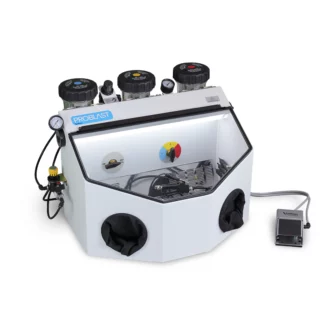This guide will help you use abrasive blasting to remove coatings from PCB’s and circuit boards. In particular, how to remove parylene remove various coatings, including conformal coating with abrasive blasting using a sandblaster.
if you’re looking for something more in depth, check our Ultimate Guide to Conformal Coating Removal.
STEP 1: Determine the type of conformal coating that needs to be removed
- Epoxy – Humidity, chemical, and abrasion resistant. Good dielectric properties.
- Acrylic – Humidity resistant and easy to work with. Poor chemical and abrasion resistance.
- Urethane – Humidity, chemical, and abrasion resistant. Good dielectric properties.
- Silicone – Humidity, chemical, and thermal resistant. High dielectric properties.
- Parylene – Humidity, moisture, abrasion, thermal, and chemical resistant. Low dielectric properties.
- UV Materials – Determined by the acylated oligomer. UV materials drastically reduce the amount of volatile organic compounds (VOC) emission levels and reduce cure time.
STEP 2: Invest in an ESD Blaster to reduce the chances of burning out components with static discharge
During the blasting process, there can be a build-up of static caused by compressed air and abrasive moving through the system; this could potentially ruin some components on the circuit board. To counteract the static charge an ESD blaster should be used, like the Master Problast 3 ESD.
These blasters continuously cycle ionized air into the cabinet to prevent a build-up of static electricity during the blasting process and provide a near-neutral static environment.
RELATED INFOGRAPHIC: Sandblaster Nozzle Tip Sizes – How to Find the Right Size (Chart)
STEP 3: Decide which abrasive will would work best to remove your conformal coating
READ: The Vaniman Guide to Microabrasive Sandblasting Media
All conformal coating can be removed with Walnut Shell, Sodium Bicarbonate, and Aluminum Oxide. Each abrasive “cuts” a little more than the last, so based on how fast or aggressive you want to remove the conformal coating will determine the abrasive that you use. We recommend using Sodium Bicarbonate because it cuts less than Aluminum Oxide and more than Walnut Shell.
It can be washed easily and is non-conductive; this is good because the goal is to not damage the components or remove any silk screening under the conformal coating. Walnut Shell is a good choice as well because it is an organic material making disposal simple and easy. However, it doesn’t “cut” as well as Sodium Bicarbonate increasing blasting time.
For aggressive blasting, Aluminum Oxide can be used in a controlled fashion but make sure to test it before production. Once you find an abrasive you feel comfortable with, start adjusting the air pressure to fine tune your blaster. If you want to “cut” a little bit faster, increase the air pressure in ~5PSI increments.
If you are still having a hard time dialing in the right abrasive to air pressure ratio, try different abrasive sizes. A general rule of thumb is the larger the material the less the abrasive will “cut”.
By experimenting with different types and sizes of abrasive, as well as air pressure, you will soon become an expert at removing conformal coating with a sandblaster. This method is the fastest and easiest way to remove conformal coating but it may take some time to get the exact results you are looking for. If you have any questions about our blaster please don’t hesitate to book a time to speak with a Product Specialist:




[…] In the event the acrylic can’t be removed using the previous three methods, a Micro-Blaster can be used to carefully get rid of the conformal coating. For more information, click on how to remove conformal coating with sandblaster. […]